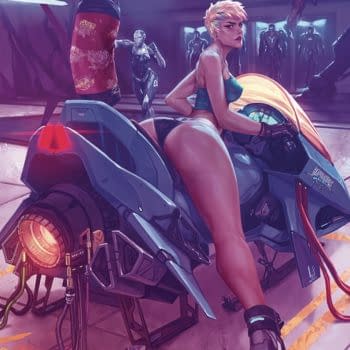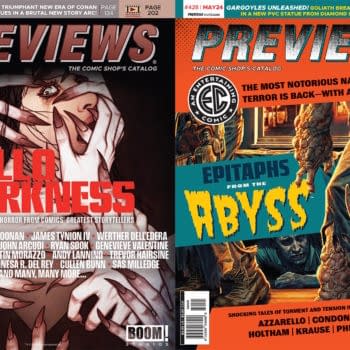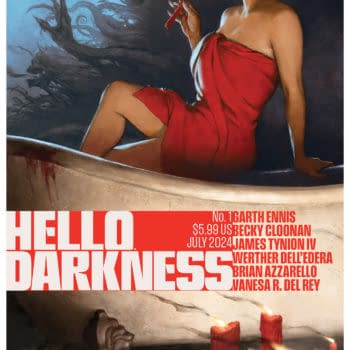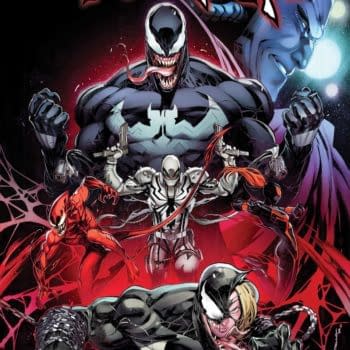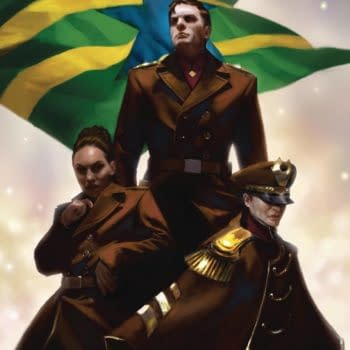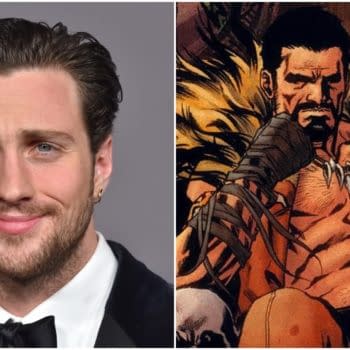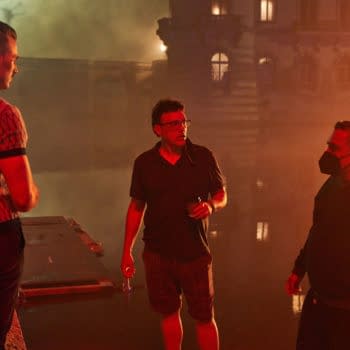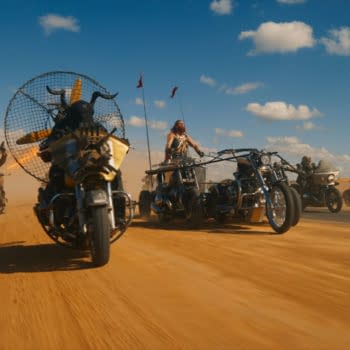Posted in: Movies | Tagged:
Look! It Moves! by Adi Tantimedh: The Girl With The Remade Tattoo
I was planning to write about how TV shows that started out good tend to go to shit past their third seasons this week, but found myself more curious about the box office failure and cultural impact (or lack thereof) of David Fincher's adaptation of THE GIRL WITH THE DRAGON TATTOO.
To the surprise of very few people, the Fincher film opened this past week and failed to make decent coin at the box office, even despite a massive advertising campaign in the months leading up to its release and an early opening on Wednesday. When I saw it, the cinema was just about half-full as opposed to the showing of TINKER, TAILOR, SOLDIER, SPY I went to that was so packed that some people had to watch it standing up. These were not free preview screenings but regular paid screenings.
Stieg Larsson's book was considered the hottest book property of the last few years when it became a runaway hit in the publishing world, offering a more adult and darker appeal for female readers who have moved past the TWILIGHT series. The MILLENIUM trilogy has been a hit primarily because of the female readership, which drives the book market these days. It's been suggested that this is down to the character of Lisbeth Salander tapping into women's latent anger at abuse at the hands of men, though the easier way to say it is that the female audience wants to see heroines who can fight back and kick ass. Considering the Swedish movie version had already made over $115 million dollars worldwide, and given how many copies the book had sold already, this was considered the hot project that everyone wanted in on. When David Fincher signed on to direct it, there was virtually nobody that didn't think he was the absolute right choice, given his long history of dark, gritty serial killer movies with an auteur's philosophical bent and that the Swedish movie's style already seemed heavily influenced by his work to start with. The casting of Lisbeth Salander was a hot topic and virtually every ingénue in her twenties was desperate for the role, with Carey Mulligan one of the most public campaigners and rumour of Kristen Stewart, Natalie Portman and just about anyone else you can think of before Fincher announced Rooney Mara as his pick. And for the last two years, producers and studios have been desperately combing books and foreign properties looking for a franchise that might be "the next Lisbeth Salander".
It's interesting to contrast and compare the Swedish and Hollywood versions of the book if you've seen both, and speculate on why the Swedish version was a hit and the Hollywood version failed. Some people might argue about whether Noomi Rapace was better in the original Swedish version than Rooney Mara. Granted, Rapace's portrayal was had more animal cunning and dangerous rage, had a stronger air of independence while Mara appeared more lost and vulnerable, and Mara seemed closer to the character described in the book. Stylistically, the Swedish version was naturalistic and matter-of-fact while Fincher's is all hyperreal, ruthlessly tight and quick edits and elaborately and self-consciously beautiful composed shots. When you watch the Swedish version, you get a sense of the characters as people going about their lives, whereas the Fincher version is filled with movie stars whose charisma threatened to overshadow the actual roles they were playing. You can tell the tone and preoccupations of the title sequence of Fincher's version, which looks like the S&M Goth version of a James Bond title sequence.
There's also a debate over whether Fincher's version might feel more exploitative than the Swedish version. The marketing campaign has gone to great lengths to fetishise Mara's Salander with not only that risqué post but several other publicity shots and fashion spreads as well, which feels odd and dissonant with a character who may flaunt her sexuality, but whose past history of physical and sexual abuse is closely tied to her identity. There might be a little too much male gaze in the Hollywood version. Fincher has also made the two rape scenes longer and even more ritualised than in the more matter-of-fact portrayal in the Swedish version. Fincher even goes as far as showing the clichéd, agonized after-rape shower scene that Hollywood has done hundreds of times in the 70s and 80s to the point where Eli Roth even made a pointed to mock it in HOSTEL 2. There are executives and analysts in Hollywood who wondered if women, the main fans of the books, have been turned off by the sense of a leering male gaze in the marketing of the movie prior to release, and given that the plot involves the gruesome serial killing of women and the rape of its heroine, might have decided not to see it. The attempt at counter-marketing at Christmas where movies released in this period are generally aimed at family audiences and feel-good stories seems to have failed. There's also the question of whether the people who really wanted to see a movie of the book already had their thirst sated by seeing the Swedish version. And could it be that Lisbeth Salander might be too scary, too 'outsider' – she's pierced, tattooed, bisexual, aggressive, an outlaw – for mainstream or Middle America? I'm sure some execs will insist she's just too threatening to people who prefer their heroines more feminine, submissive and generally non-threatening.
In many places, Fincher's version follows the book more closely than the Swedish movie did, maybe too faithfully. In Fincher's version, the movie keeps going for another 20 minutes after the central mystery and thriller plot had been resolved. The Swedish version changed the ending to a shorter, more satisfying and triumphant note whereas the book and Fincher's movie ended on an air of muted disappointment, complete with a funereal dirge of a song over the end credits. I've been taught by many producers and even Robert McKee that the most successful movies end with a feeling of, in not triumph, then at least an up note. Even if the ending is tragic, you can mitigate it with a punchy song over the end credits to at least lift the audience a bit as they leave the cinema. You could have the greatest script, performances and direction ever but if you end on a downer, your movie might fail at the box office, and Fincher's adaptation might have broken the cardinal rule.
The failure of the Hollywood version of DRAGON TATTOO isn't just going to send Hollywood producers and executives further into further fits of soul-searching as they worry about what exactly is going to appeal to audiences in an era where box office earnings are steadily declining, but also the continuing search for the formula for a successful female-driven thriller franchise. The latter has been a kind of gender war waging in the Hollywood since the 1990s between writers, directors and producers who believed a viable female action franchise could be successful and those who didn't believe audiences want to see a female action hero. Countless original screenplays and new characters were created throughout the 1990s that never saw the light of day. THE LONG KISS GOODNIGHT was a hot script by Shane Black but failed to turn Geena Davis into the female Bruce Willis. SALT, originally written with a male hero in mind and offered to Tom Cruise, did okay with Angelina Jolie but never scaled the heights of the box office stratosphere. Steven Soderbergh's upcoming HAYWIRE starring fighter Gina Carano is considered a B movie and technical exercise by Hollywood at best, which muted buzz.
I think we're past the point of Hollywood not bothering to try to find a female action franchise anymore because the female audience has become too big to ignore. The quest is where are they going to look next. I suspect the next test for the genre will be the movie adaptation of THE HUNGER GAMES, with its presold audience of millions of teenagers, featuring an action heroine not out for revenge, but for survival and protection of first her sister and then the two boys she's fallen in love with. Unlike Lisbeth Salander, Katniss Everdeen is less likely to taser you if you look at her funny and more mainstream-friendly. Katniss is about protectiveness. Lisbeth Salander is about rage and revenge. She's the imp of the unconscious that many women harbour in their psyches, but perhaps best kept hidden, private and cherished, not brought into gaudy light by Hollywood. Rooney Mara's performance may be utterly committed and faultless in her sullen defensiveness and secret yearning for love, but it is Noomi Rapace who found the independent, self-contained Salander that doesn't give a damn about anyone's approval.
Tattoo-free at lookitmoves@gmail.com
Follow the official LOOK! IT MOVES! twitter feed at http://twitter.com/lookitmoves for thoughts and snark on media and pop culture, stuff for future columns and stuff I may never spend a whole column writing about.
Look! It Moves! © Adisakdi Tantimedh













